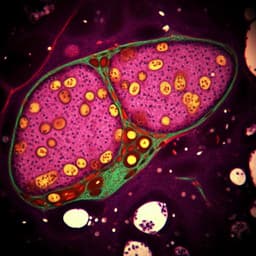
Psychology
The effects of polygenic risk for psychiatric disorders and smoking behaviour on psychotic experiences in UK Biobank
J. García-gonzález, J. Ramírez, et al.
Discover how smoking and genetics intertwine to influence psychotic experiences in this captivating study by Judit García-González, Julia Ramírez, David M. Howard, Caroline H. Brennan, Patricia B. Munroe, and Robert Keers. The research delves into the impact of smoking behavior and genetic predisposition on psychiatric disorders, unveiling significant associations that challenge our understanding of mental health.
~3 min • Beginner • English
Introduction
Psychotic experiences, including hallucinations and delusions, occur in 5–10% of the general population and are core symptoms of severe mental disorders such as schizophrenia. Understanding their etiology can inform risk identification and prevention strategies. Prior evidence shows substantial genetic influence, with twin studies attributing 30–50% of variance and common genetic variants explaining 3–17%. Genetic liability to psychiatric disorders correlates with psychotic experiences, and PRSs for schizophrenia, bipolar disorder, depression, and ADHD explain small but significant proportions of variance in psychotic experiences. Environmental factors explain roughly half to two-thirds of variance, with smoking being a well-established risk factor and potentially causal. However, it is unclear whether smoking’s association with psychotic experiences is independent of genetic liability to psychiatric disorders and whether smoking interacts with such genetic liability. This study aims to: (1) test associations between smoking phenotypes (current/former/never status, pack-years, maternal smoking around birth) and lifetime psychotic experiences (delusions, hallucinations, any) in UK Biobank; (2) assess whether these associations are independent of psychiatric diagnoses and PRSs for schizophrenia, bipolar disorder, depression, and ADHD; and (3) test gene–environment interactions between smoking and PRSs on psychotic experiences.
Literature Review
Background studies indicate psychotic experiences share genetic liability with psychiatric disorders: PRSs for schizophrenia, bipolar disorder, depression, and ADHD explain approximately 0.11%, 0.06%, 0.32%, and 0.05% of variance in psychotic experiences, and LDSC-estimated genetic correlations with schizophrenia, bipolar disorder, depression, and ADHD are 0.21, 0.15, 0.46, and 0.24, respectively. Environmental contributions are substantial (50–70%), with smoking consistently associated with psychosis and psychotic experiences, supported by longitudinal, dose–response, and Mendelian randomization evidence suggesting causality. Some reports suggest former smokers may not have elevated risk, although power limitations could underlie null findings. Maternal smoking during pregnancy has been associated with offspring psychotic experiences in observational studies, but within-family designs attenuate these associations, implicating familial confounding. PRSs for psychiatric disorders are themselves associated with smoking behaviors, raising the possibility of shared genetic factors underlying both smoking and psychotic experiences. Gene–environment interactions have been reported for psychiatric outcomes, yet interactions between smoking and psychiatric PRSs on psychotic experiences had not been thoroughly tested prior to this study.
Methodology
Design and cohort: Data were drawn from UK Biobank (UKB), a population-based cohort of ~500,000 participants. A total of 157,366 participants completed an online mental health questionnaire used to define psychotic experiences. Ethical approval was granted by UKB (Application ID#42423), and all participants provided consent.
Psychotic experience phenotypes: Lifetime delusions (delusions of reference and/or persecutory delusions; Field IDs 20474, 20468), lifetime hallucinations (visual and/or auditory; Field IDs 20471, 20463), and any psychotic experience (endorsement of any of the four items) were defined via the Composite International Diagnostic Interview items in the mental health questionnaire. Controls were participants without any lifetime psychotic experiences.
Smoking phenotypes: Three smoking measures from baseline were used: smoking status (never, former, current; Field ID 20116), pack-years of smoking (Field ID 20161; calculated as cigarettes/day divided by 20 multiplied by years smoked; defined for former and current smokers), and maternal smoking around birth (Field ID 1787; yes/no to whether mother smoked regularly around time of participant’s birth).
Other psychiatric disorders: Lifetime depression, ADHD, schizophrenia, mania, hypomania, bipolar or manic depression, and other psychotic disorders were defined using baseline and mental health questionnaire data (see supplementary tables referenced in the article).
Genetic data and QC: 488,377 individuals were genotyped on UKB Axiom or UK BILEVE Axiom arrays. Imputation was performed centrally using IMPUTE2 with the Haplotype Reference Consortium panel. Standard QC excluded individuals with poor call rate (>5%) and sex discordance. The first two principal components (PCs) were used in k-means clustering to identify a genetically homogeneous subsample; related individuals (kinship coefficient > 0.0884) were removed per phenotype using ukbtools. Analyses of PRS were restricted to 144,818 participants of European ancestry after QC (details in supplementary materials).
Polygenic risk scores: PRS for schizophrenia (PRSscz), major depression (PRSDEP), ADHD (PRSADHD), and bipolar disorder (PRSBP) were computed using PRSice-2 with discovery GWAS summary statistics from recent large meta-analyses. Logistic regressions (implemented in PRSice-2) tested associations between PRSs and psychotic experiences, adjusting for the first ten genetic PCs and genotyping batch.
Main effect analyses: Regression models tested associations between smoking phenotypes (status, pack-years, maternal smoking) and psychotic experiences (delusions, hallucinations, any). Models were then adjusted for diagnoses of psychotic disorders, depression, and ADHD, and further adjusted by including the PRS with the highest predictive ability for psychotic experiences at p-value threshold 0.2 to assess independence of smoking effects from psychiatric diagnoses and genetic liability.
Interaction effect analyses: Gene–environment interactions (GxE) between each PRS (PRSscz, PRSDEP, PRSADHD, PRSBP) and smoking phenotypes were tested on multiplicative (logistic regression) and additive (linear regression) scales. Independent variables included the PRS, smoking phenotype, their interaction, ten PCs, genotyping batch, and interactions of smoking and PRS with PCs and batch to control for confounding. Dependent variables were lifetime delusions, hallucinations, or any psychotic experience. Multiple testing correction used a threshold p < 0.0021 (0.05/24) across 24 models (four PRSs × three psychotic phenotypes × two interaction scales). Sample sizes for GxE models were n = 143,320 (any), n = 143,043 (hallucinations), and n = 143,245 (delusions).
Sensitivity analyses: To address potential inflation of PRS effects by inclusion of individuals with psychotic disorders, significant GxE findings were re-tested after excluding participants meeting criteria for psychotic disorders.
Descriptive data: Among 157,366 respondents, cases were 2,067 for delusions, 6,689 for hallucinations, and 7,803 for any psychotic experience; controls numbered 155,182, 150,336, and 149,289, respectively. In the broader cohort, 273,542 were never smokers, 173,072 former smokers, and 52,979 current smokers; mean pack-years was 23.4 (SD 18.8). Maternal smoking around birth was reported by 126,632 and denied by 306,266 individuals.
Key Findings
- Smoking and psychotic experiences: Current and former smoking status, maternal smoking around birth, and higher pack-years were each associated with increased odds of lifetime delusions, hallucinations, and any psychotic experience (p < 1.77 × 10−5). Associations were strongest for current smoking versus never smoking.
- Independence from diagnoses and PRSs: After adjusting for diagnoses of psychotic disorders, depression, and ADHD, and for psychiatric PRSs, associations largely remained significant (p < 1.99 × 10−3), indicating effects of smoking and maternal smoking are not fully explained by psychiatric diagnoses or polygenic liability. The exception was pack-years, for which effects were attenuated and not consistently significant after adjustment.
- Gene–environment interactions: Significant interactions were observed between smoking status (current vs never) and PRSDEP and PRSADHD on lifetime delusions on the additive scale (p < 0.002 after multiple testing correction); the combined effects exceeded the sum of individual effects. No significant interactions were found for PRSscz or PRSBP with smoking status, nor for any PRS with smoking status on hallucinations or on any psychotic experience.
- No GxE with maternal smoking or pack-years: No significant interactions were detected between any PRS and maternal smoking around birth or pack-years of smoking.
- Sensitivity analyses: Excluding individuals with psychotic disorders did not eliminate the significant smoking status × PRSDEP and smoking status × PRSADHD interactions on delusions; all interaction terms remained significant.
- Sample sizes: Psychotic experience cases were n=2,067 (delusions), n=6,689 (hallucinations), n=7,803 (any); GxE analyses included roughly 143,000 participants per phenotype.
Discussion
Findings demonstrate robust associations between smoking behaviors (current/former status, maternal smoking, and dose by pack-years) and lifetime psychotic experiences in a large population-based sample. These associations persisted after adjusting for psychiatric diagnoses and polygenic liabilities, indicating that smoking contributes independently to psychotic experiences beyond shared genetic risk for psychiatric disorders. Crucially, gene–environment interaction analyses revealed that genetic predisposition captured by PRS for depression and ADHD amplifies risk for delusions specifically among current smokers, consistent with synergistic effects on particular psychotic experience subtypes. The absence of interactions for PRSscz or PRSBP, and for hallucinations or the combined psychotic experience outcome, suggests heterogeneity in how genetic liabilities and environmental exposures combine across different psychotic symptoms. Lack of interaction with maternal smoking or smoking dose by pack-years indicates that current smoking status may be the most salient moderator of genetic risk effects on delusions. These results support models in which smoking and certain psychiatric polygenic risks jointly influence psychotic experiences, with implications for targeted prevention among genetically susceptible individuals who smoke.
Conclusion
This study shows that smoking status, maternal smoking around birth, and smoking dose are associated with lifetime psychotic experiences, largely independent of psychiatric diagnoses and polygenic risk for major psychiatric disorders. Moreover, current smoking synergistically enhances the effects of polygenic risk for depression and ADHD on delusions, highlighting symptom-specific gene–environment interplay. These findings underscore the importance of integrating environmental risk factors like smoking with genetic risk profiling when assessing susceptibility to psychotic experiences. Future work should clarify mechanisms underlying the PRSDEP/PRSADHD × smoking interactions, evaluate temporal and causal pathways, investigate symptom-specific etiologies, and consider intervention studies targeting smoking cessation in genetically at-risk groups to reduce delusional experiences.
Limitations
Related Publications
Explore these studies to deepen your understanding of the subject.







